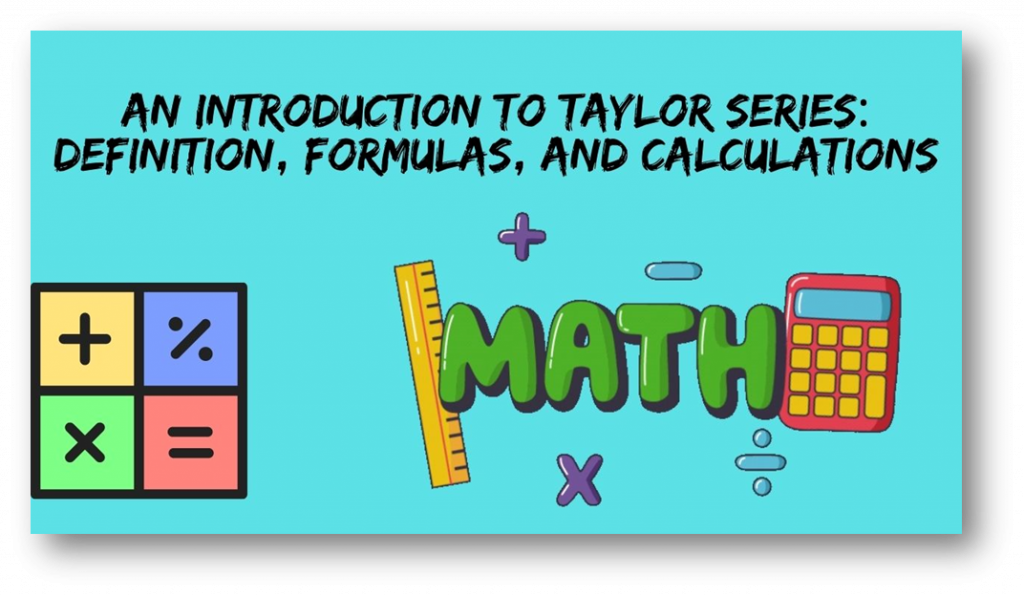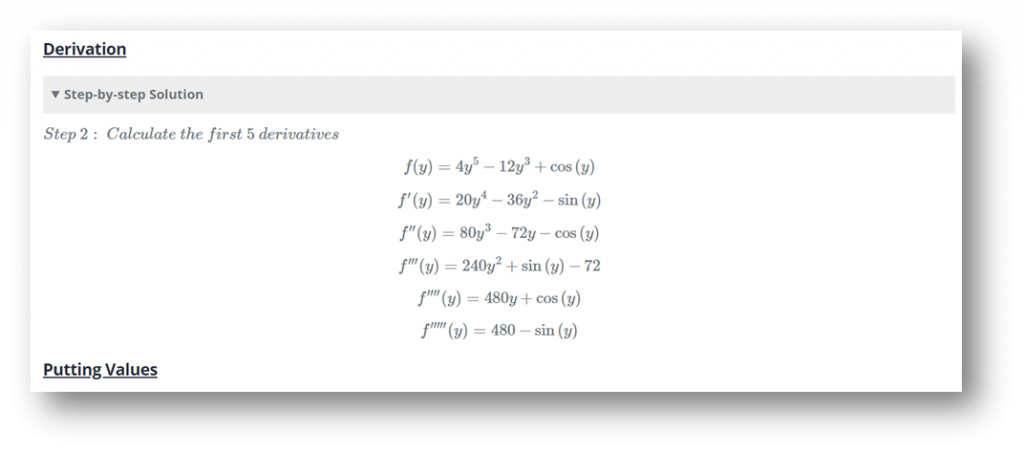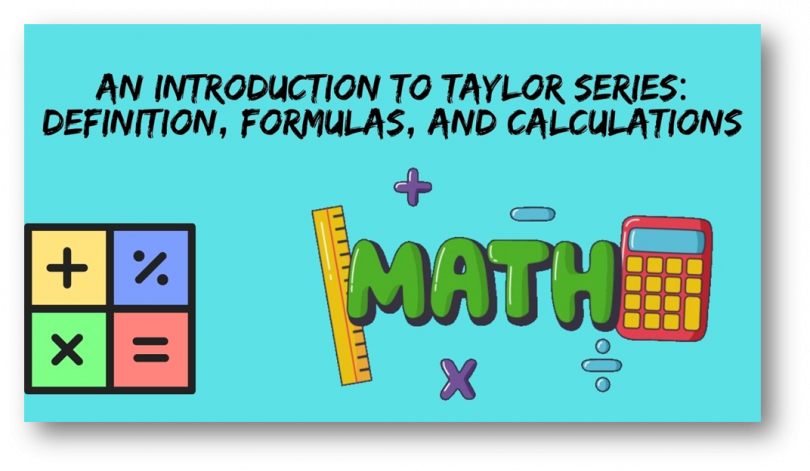
The term Taylor series is an expansion widely used concept in mathematics, machine learning, optimization theory, and function approximation. The Taylor series is widely used in numerical computations to evaluate the estimate of the values of algebraic, trigonometric, and polynomial functions at various points.
In this article, we will learn the definition, formulas, and how to expand the functions at different points along with examples.
What is the Taylor series?
According to khan Academy:
“A Taylor series approximates any function as a polynomial with an infinite number of terms. A Taylor polynomial is formed by taking the derivatives of a function at a single point in time.” It can also be defined as a series used to define any real or complex function f(y) that’s infinitely differentiable.
The function must be continuous to expand it in an infinite series. As each algebraic, trigonometric, and polynomial functions must be differentiable and specific point must be applied in differentiable function.
Taylor series expression
Mathematically, it can be written as:
F(y) = f(a) + [f’(a) (y – a)]/ 1! + [f’’(a) (y – a)2]/ 2! + [f’’’(a) (y – a)3] / 3! + … + [f n (a) (y – a) n]/ n!
The expression of the Taylor polynomial can also be written in the form of sigma notation.

- F(y) = the Taylor polynomial expansion of the given algebraic, polynomial, and trigonometric functions.
- “a” = the specific limit value of the function.
- “n” = the number of derivatives are to be taken for expansion.
- “fn(a)” = the result of the differentiated function at specific point.
Maclaurin Series
The term Taylor series is said to be the Maclaurin series if the central point of the given expression is zero.
F(y) = f(0) + [f’(0) (y)]/ 1! + [f’’(0) (y)2]/ 2! + [f’’’(0) (y)3] / 3! + … + [f n (0) (y) n]/ n!
The expression of the Maclaurin series can also be written in the form of sigma notation.

Steps to solve Taylor series
Here are a few steps that are helpful in calculating the Taylor series.
- First of all, find the first few derivatives of the given function f(y), such as f’(y), f’’(y), f’’’(y), etc.
- Find the value of given function and differentiated function at the specific point y = a.
- Substitute the calculated values in the general expression of Taylor series.
- Write the final result.
Example of evaluating the Taylor series
Here is an example of the Taylor series that is helpful for understanding how to evaluate the Taylor series either by using calculator or manually.
Example
Expand the given function f(y) = cos(y) + 4y5 – 12y3, if the specific point is y = 2 and the order of the function is 5.
Solution
By using a Taylor Series Calculator
Step 1: Enter the given function, specific point, and order of derivative into the required input fields.

Step 2: Press the calculate button.

Step 3: The result will show below the calculate button.

Step 4: Press show more to view the step by step solution to the given problem.

By solving manually
Step 1: First of all, find the first 5 derivatives of the given function.
f’(y) = d/dy [cos(y) + 4y5 – 12y3] = -sin(y) + 20y4 – 36y2
f’’(y) = d/dy [-sin(y) + 20y4 – 36y2] = -cos(y) + 80y3 – 72y
f’’’(y) = d/dy [-cos(y) + 80y3 – 72y] = sin(y) + 240y2 – 72
f’’’’(y) = d/dy [sin(y) + 240y2 – 72] = cos(y) + 480y – 0
f’’’’’(y) = d/dy [cos(y) + 480y] = -sin(y) + 480
Step 2: Now find the value of given function and differentiated function at the specific point y = 2.
f(2) = cos(2) + 4(2)5 – 12(2)3 = cos(2) + 4(32) – 12(8) = cos(2) + 128 – 96 = cos(2) + 32
f’(2) = -sin(2) + 20(2)4 – 36(2)2 = -sin(2) + 20(16) – 36(4) = -sin(2) + 320 – 144 = -sin(2) + 176
f’’(2) = -cos(2) + 80(2)3 – 72(2) = -cos(2) + 80(8) – 72(2) = -cos(2) + 640 – 144 = -cos(2) + 496
f’’’(2) = sin(2) + 240(2)2 – 72 = sin(2) + 240(4) – 72 = sin(2) + 960 – 72 = sin(2) + 888
f’’’’(2) = cos(2) + 480(2) = cos(2) + 960
f’’’’’(2) = -sin(2) + 480
Step 3: Substitute the calculated values in the general expression of Taylor series.

Put n = 5 in the above summation form and write the series.

F(y) = f(a) + [f’(a) (y – a)]/ 1! + [f’’(a) (y – a)2]/ 2! + [f’’’(a) (y – a)3] / 3! + [f’’’’(a) (y – a)4] / 4! + [fv(a) (y – a)5] / 5! … equation (1)
F(y) = cos(2) + 32 + [-sin(2) + 176 (y – 2)]/ 1! + [-cos(2) + 496 (y – 2)2]/ 2! + [sin(2) + 888 (y – 2)3] / 3! + [cos(2) + 960 (y – 2)4] / 4! + [-sin(2) + 480 (y – 2)5] / 5!
Step 4: Now write the final result.
F(y) = cos(2) + 32 + [-sin(2) + 176 (y – 2)]/ 1 + [-cos(2) + 496 (y – 2)2]/ 2 + [sin(2) + 888 (y – 2)3] / 6 + [cos(2) + 960 (y – 2)4] / 24 + [-sin(2) + 480 (y – 2)5] / 120
F(y) = cos(2) + 32 + [-sin(2) + 176 (y – 2)] + [-cos(2) + 496 (y – 2)2]/ 2 + [sin(2) + 888 (y – 2)3] / 6 + [cos(2) + 960 (y – 2)4] / 24 + [-sin(2) + 480 (y – 2)5] / 120
Hence the process of finding the Taylor series of the given function is easy with the help of online Taylor series calculator by limitcalculator.online rather than finding it manually as there is large number of calculations to perform.
Here are some well-known function’s expansions.
| Function | Taylor Expansion |
| ey at y = 0 | 1 + y + y2 /2! + y3 /3! + y4 /4! + y5/5! + … |
| Sin(y) | y – y3/3! + y5/5! – y7/7! + y9/9! – … |
| Cos(y) | 1 – y2/2! + y4/4! – y6/6! + y8/8! – … |
| Tan(y) | y + y3/3 + 2y5/15 + 17y7/315 + 62y9/2835 + … |
| y2 + cos(y) | 1 – y2/2 + y4/24 + y5 – y6/720 + … |
Frequently asked questions
What is a Taylor series used for?
A Taylor series is a mathematical concept found in computer science, calculus, chemistry, physics, and other fields of higher mathematics. A function’s estimate (guess) is created by using a series of operations. Taylor series can also be classified as Maclaurin series with center at 0.
Why do we use Taylor and Maclaurin series?
It is very important to understand Taylor and Maclaurin Series when we want to express a function as a power series with different central points (limit points).
What is the difference between Taylor series and Maclaurin?
In math, a Taylor Series or Taylor Polynomial consists of an infinite sum of terms calculated from the derivatives of a function at a single point. Maclaurin series is a special case of Taylor series, which have zero as the specific point.
Conclusion
Now you can grab the basics of the Taylor series from this post as we have discussed the definition, formula, and solved example. Once you understand the basics of this post, you will be able to expand any algebraic, trigonometric, and polynomial functions.


